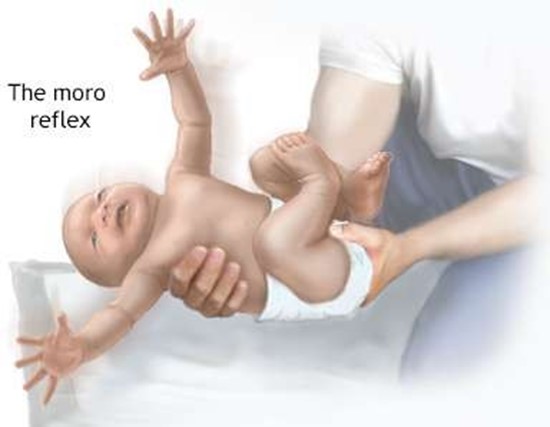A nurse is checking a newborn’s Moro reflex.
Which of the following actions should the nurse take to elicit this reflex?
Place the newborn on their abdomen and observe the movement of their extremities.
Stroke the newborn’s cheek toward their mouth.
Stroke upward on the lateral aspect of the newborn’s foot.
Place the newborn on a flat surface and clap hands loudly.
The Correct Answer is D
Place the newborn on a flat surface and clap hands loudly.

This action will elicit the Moro reflex, also known as the startle reflex, which is a normal, involuntary reaction that newborns and infants have when they’re startled. In response to the sound, the baby will throw back his or her head, extend out his or her arms and legs, cry, then pull the arms and legs back in.
Choice A is wrong because placing the newborn on their abdomen and observing the movement of their extremities will not trigger the Moro reflex.
This position may elicit other reflexes such as the crawling reflex or the tonic neck reflex.
Choice B is wrong because stroking the newborn’s cheek toward their mouth will not trigger the Moro reflex. This action will elicit the rooting reflex, which helps the baby find the breast or bottle to start feeding.
Choice C is wrong because stroking upward on the lateral aspect of the newborn’s foot will not trigger the Moro reflex. This action will elicit the Babinski reflex, which causes the big toe to extend upward and the other toes to fan out.
Nursing Test Bank
Naxlex Comprehensive Predictor Exams
Related Questions
Correct Answer is B
Explanation
Ask the client to empty their bladder.

This is because a full bladder can interfere with the pelvic examination and cause discomfort to the client. The nurse should also instruct the client to avoid douching, using tampons, vaginal medications, sprays, powders, birth control foam, cream, or jelly for at least 24 hours before the exam.
Choice A is wrong because the client should be placed in a lithotomy position, not a prone position, for a pelvic examination.
Choice C is wrong because douching can alter the normal vaginal flora and pH, and increase the risk of infection.
Choice D is wrong because placing the client’s arms over their head can tighten the abdominal muscles and make the examination more difficult. The nurse should ask the client to place their arms at their sides or across their chest.
Correct Answer is A
Explanation
Proteinuria is the presence of excess protein in the urine, which is a hallmark of nephrotic syndrome. Nephrotic syndrome is a kidney disorder that causes increased permeability of the glomerular basement membrane, leading to loss of protein and other substances in the urine.
Choice B is wrong because hypolipidemia is a low level of lipids in the blood, which is not expected in nephrotic syndrome. On the contrary, nephrotic syndrome causes hyperlipidemia, which is a high level of lipids in the blood, due to increased synthesis and decreased clearance of lipoproteins.
Choice C is wrong because hyperalbuminemia is a high level of albumin in the blood, which is not expected in nephrotic syndrome. On the contrary, nephrotic syndrome causes hypoalbuminemia, which is a low level of albumin in the blood, due to loss of albumin in the urine and decreased synthesis by the liver.
Choice D is wrong because increased hemoglobin is not expected in nephrotic syndrome. On the contrary, nephrotic syndrome can cause anemia, which is a low level of hemoglobin in the blood, due to loss of iron and erythropoietin in the urine and decreased production of red blood cells by the bone marrow.
Normal ranges for proteinuria are less than 150 mg per day or less than 10 mg per deciliter on a random urine sample. Normal ranges for serum lipids are total cholesterol less than 200 mg per deciliter, LDL cholesterol less than 100 mg per deciliter, HDL cholesterol more than 40 mg per deciliter for men and more than 50 mg per deciliter for women, and triglycerides less than 150 mg per
deciliter. Normal ranges for serum albumin are 3.5 to 5.0 grams per deciliter.
Whether you are a student looking to ace your exams or a practicing nurse seeking to enhance your expertise , our nursing education contents will empower you with the confidence and competence to make a difference in the lives of patients and become a respected leader in the healthcare field.
Visit Naxlex, invest in your future and unlock endless possibilities with our unparalleled nursing education contents today
Report Wrong Answer on the Current Question
Do you disagree with the answer? If yes, what is your expected answer? Explain.
Kindly be descriptive with the issue you are facing.
